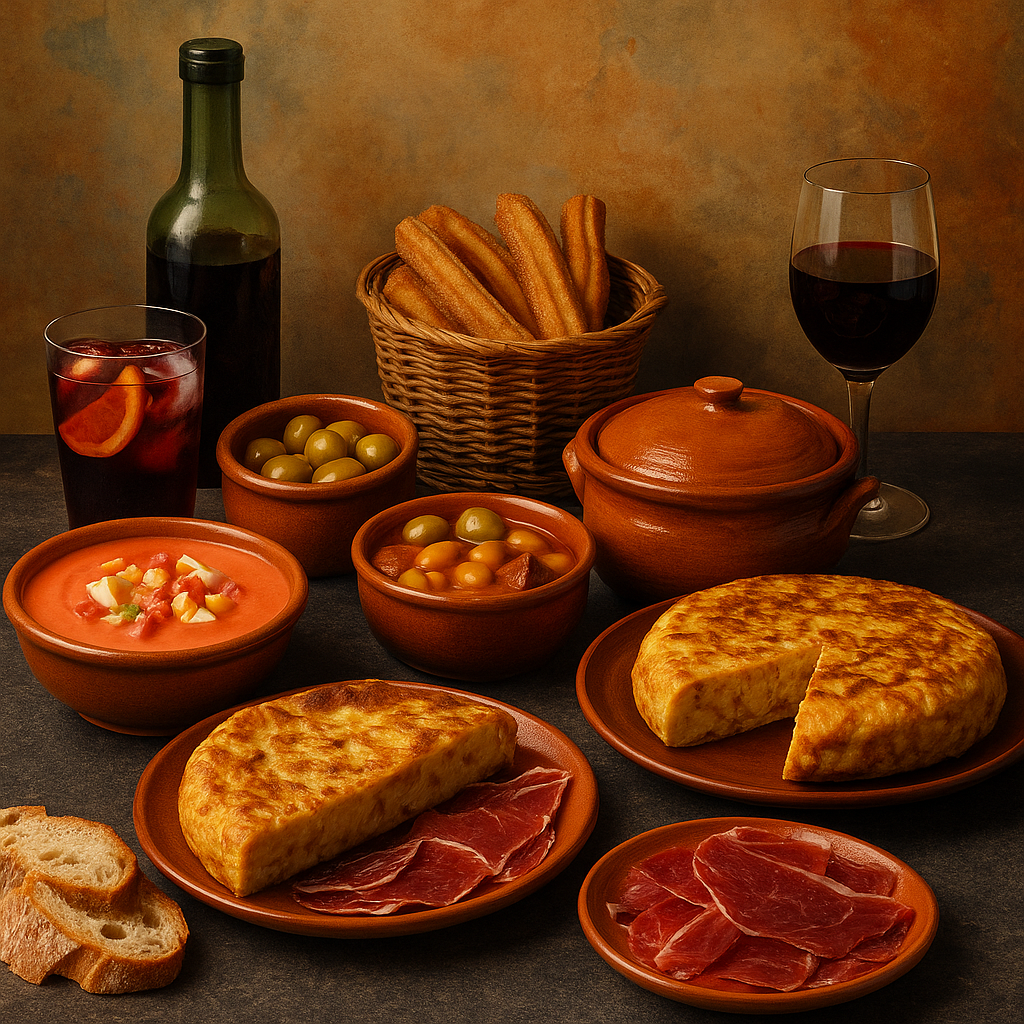What Spaniards Really Eat: A Culinary Tour from Royal Kitchens to Daily Plates
Spain’s cuisine mirrors its culture—warm, vibrant, diverse, and deeply rooted in tradition. Whether it’s the daily meals of the typical household or the delicacies once served in royal courts, Spanish food is all about simple ingredients elevated through generations of tradition. This ultimate food and drink guide uncovers what Spaniards eat daily, the flavours defining regions, and the vintage restaurants where time stands still.
What Do Spanish People Eat Daily?
The Spanish day revolves around several meals: a light breakfast, a mid-morning snack (almuerzo), lunch (comida), an evening snack (merienda), and a late dinner (cena).
Breakfast (Desayuno)
Usually light—think tostada con tomate (crusty toast with crushed tomato and olive oil), magdalenas (Spanish muffins), or churros with hot chocolate.
Lunch (Comida)
The most essential meal often includes:
Lentejas – Lentil stew with vegetables and sausage.
Tortilla Española – The beloved Spanish omelette of eggs and potatoes.
Cocido Madrileño – A chickpea-based stew with meat and vegetables, ubiquitous in winter.
Gazpacho or Salmorejo – Cold tomato-based soups in summer.
Dinner (Cena)
Lighter than lunch and often includes tapas or small plates:
Pimientos de Padrón – Small green peppers blistered in olive oil.
Jamón Ibérico & Queso Manchego – Ham and cheese with bread or wine.
Grilled fish or eggs with vegetables.
Royal Influence in the Kitchen
Spanish royalty historically enjoyed extravagant versions of everyday dishes:
Sopa de Ajo (Garlic Soup) – A humble dish elevated with poached egg and jamón.
Partridge in Escabeche – A nobleman’s dish, still served in Castilian estates.
Truchas a la Navarra – Trout stuffed with ham from regal Navarre.
Where to Try These Dishes: Iconic & Vintage Restaurants
Experience timeless Spanish fare in legendary locales:
Casa Lucio (Madrid) – Famous for its huevos rotos (broken eggs on potatoes).
El Rinconcillo (Seville) – The oldest tapas bar in Spain, founded in 1670.
Botín (Madrid) – Recognized by Guinness as the world’s oldest restaurant (1725), still serving cochinillo asado (roast suckling pig).
Can Culleretes (Barcelona) – Catalonia’s oldest restaurant with a deep Catalan flavour.
Mesón de Cándido (Segovia) – Another temple of roast suckling pig, steeped in royal patronage.
Flavour Profiles Across Regions
Andalusia – Bold with olive oil, garlic, and vinegar; cold soups like salmorejo are a highlight.
Catalonia – Savory and sweet blends; nuts, dried fruits, and picada (a base of ground almonds and herbs).
Basque Country – Seafood-driven; cod (bacalao), grilled fish, and anchovies dominate.
Castile & León – Hearty, meat-based dishes with robust spices and pulses.
Valencia – Home of paella seasoned with saffron and cooked over an open flame.
Summer & Winter Drinks Spaniards Love
Summer Refreshments
Tinto de Verano – A drink made of Red wine with lemon soda or tonic.
Clara – Beer mixed with lemonade.
Horchata de Chufa – A popular sweet, milky drink made from tiger nuts (prevalent in Valencia).
Sangría – A tourist favourite, but still enjoyed in social gatherings.
Winter Warmers
Café con Leche – Spanish-style milky coffee, essential for cold mornings.
Carajillo – Coffee spiked with brandy or rum.
Hot Chocolate with Churros – Especially loved during Christmas and cold months.
Anís del Mono – A strong aniseed spirit sipped after meals.
Tips for a True Culinary Experience
Visit local markets like Mercado de San Miguel (Madrid) or Mercat de Sant Josep (La Boqueria, Barcelona).
Sign up for a food tour or cookery class—many offer insights into family recipes and cooking traditions.
Eat late—locals dine around 9–10 PM.
Don’t skip pan con tomate, the simplest but most loved dish.
Final Bite: Tradition Served Fresh
Spanish cuisine isn’t just about what’s on the plate—it’s a lifestyle. From age-old taverns serving stews born in royal kitchens to sunlit bars dishing out crunchy croquetas, every meal celebrates culture. Whether you’re sipping tinto de verano on a terrace in Seville or warming your hands with sopa de ajo in Salamanca, Spanish food brings the past to life—bite by bite.



